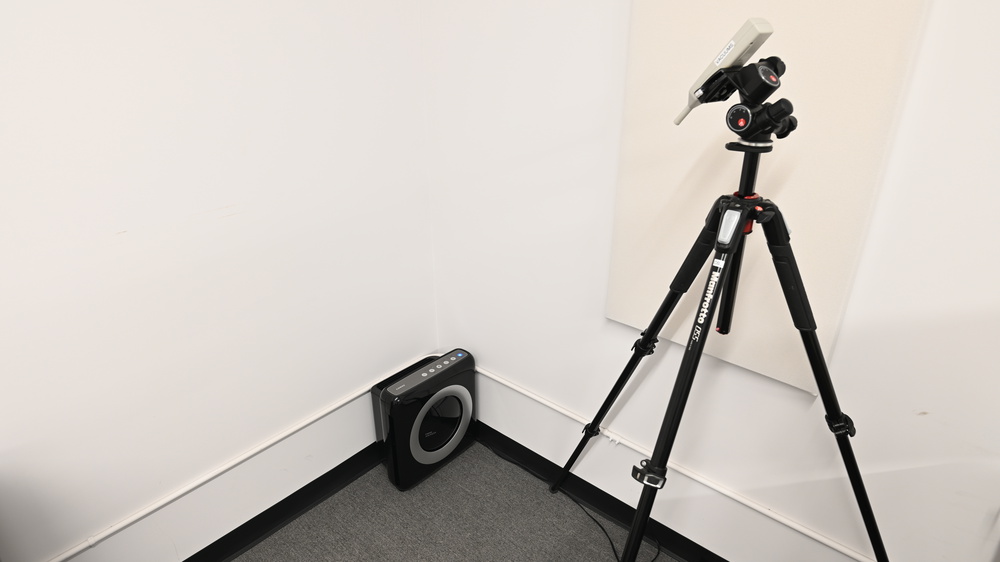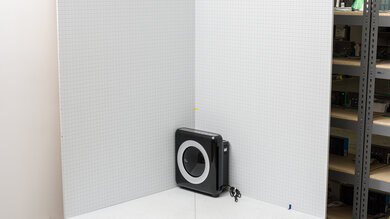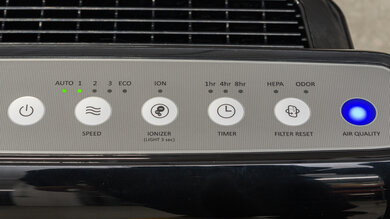The Coway Airmega AP-1512HH Mighty is an air purifier intended for medium-sized rooms. It features a three-stage filtration system and an ionizer. While there's no way of controlling the device remotely via a smartphone companion app, it does have a built-in particle sensor that allows it to monitor air quality in real-time and adjust its fan speed to match. There's also a dedicated 'Eco' mode, which automatically turns the fan off to save energy if the particulate count in the air remains below a certain threshold for 30 minutes.
Our Verdict
The Coway Airmega AP-1512HH is very good for pet owners. It does a reasonably good job of trapping fine particles like cat dander and has a reasonably fast cleaning rate, which is good for larger rooms. While you can't control the air purifier remotely using your smartphone, its particle sensor enables it to adjust its fan speed automatically depending on current air quality. Unfortunately, it might not be the best option if your pet is highly sensitive to loud noises, as it is a little noisy at higher fan speeds.
-
Automatic fan speed adjustment and 'Eco' setting.
-
Very good overall purification performance.
-
Noisy at higher fan speeds.
-
No companion app.
The Coway Airmega AP-1512HH is a good option to put in your bedroom. It won't fit on a dresser or shelf, but it still has a fairly compact footprint for a machine capable of cleaning medium-sized rooms. While there's no ability to control the device using a smartphone app, the 'Eco' mode helps minimize noise and power consumption by turning the fan off if air quality stays above what it deems acceptable. You can also easily turn off its display light, so you won't have to cover it up when you're trying to get some sleep.
-
Automatic fan speed adjustment and 'Eco' setting.
-
Very good overall purification performance.
-
Display light shutoff.
-
Noisy at higher fan speeds.
-
No companion app.
-
Automatic fan speed adjustment and 'Eco' setting.
-
Very good overall purification performance.
-
Noisy at higher fan speeds.
-
No companion app.
-
Automatic fan speed adjustment and 'Eco' setting.
-
Very good overall purification performance.
-
Noisy at higher fan speeds.
-
No companion app.
- 7.7 Pets
- 7.7 Bedroom
Performance Usages
- 7.7 Particle Filtration Rate
- 8.2 Particle Concentration
Changelog
- Updated Oct 31, 2024: Converted to Test Bench 1.0.1.
- Updated May 13, 2024: Review published.
Check Price
Differences Between Sizes And Variants
The Coway Airmega AP-1512HH is available in two color variants: 'Black' and 'White'. We tested the 'Black' variant.
Let us know in the comments if you come across another variant.
Compared To Other Air Purifiers
This is a relatively well-rounded air purifier. While it might not have the same breadth of fully automatic functionality as the similarly priced and similarly-sized Levoit Vital 200S, which you can control remotely using the VeSync companion app, the Coway is certainly worth a look if you don't want or need those kinds of features. Its 'Eco' setting can help save on energy costs and reduce noise, which is good since, at higher fan speeds, it's noisier than other alternatives.
Test Results
The 'Air Quality' indicator light changes color based on current particle count:
- Blue: Clean
- Dark Purple: Polluted
- Red: Highly Polluted
You can turn off the lights on the display by pressing and holding the 'Ionizer' button for three seconds.
While the manufacturer advertises this air purifier as having a four-stage filtration system, its actual filter has only three physical layers: a pre-filter for trapping larger particles, a True HEPA filter, and a Carbon filter for minimizing odors. The fourth 'stage' is the device's built-in ionizer. This system releases negative ions into the air that impart an electrical charge to small particles, causing them to clump together and fall to the ground or any other flat surface, where you can easily clean them up. The downside of an ionizer like this is that it also produces ozone as a byproduct, which can irritate your respiratory system through prolonged exposure. If you don't want to use the ionizer, you can turn it off.
You'll need to clean the pre-filter under water or vacuum off any stuck-on debris and dust every two to four weeks.
You'll need to replace the True HEPA/Activated Carbon filter every 12 months and the carbon filter every six months. These two filters are sold in a single pack and can be purchased here.












